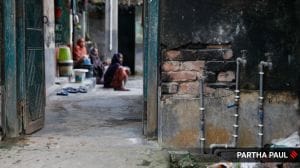Stay updated with the latest - Click here to follow us on Instagram
In the shadow of drought, Maharashtra projects 8% growth
Farm growth negative again, industrial growth slips, manufacturing up.
 CM Devendra Fadnavis at the flag hoisting ceremony of the 603 rd Urs at Mahim Dargah on Thursday.
CM Devendra Fadnavis at the flag hoisting ceremony of the 603 rd Urs at Mahim Dargah on Thursday.
Amid two consecutive drought spells and growing farm distress, Maharashtra has projected an 8 per cent growth rate in 2015-16.
According to the Economic Survey Report (ESR) 2015-16, which was presented to the state legislature on Thursday, the real gross state domestic product (GSDP) at constant (2011-12) market prices will be Rs 16,47,045 crore, up 8 per cent over 2014-15.
But the one indicator that will worry the Devendra Fadnavis-led government the most as its unveils its second budget on Friday is the negative growth projections for the agriculture sector, which impacts the livelihood of nearly 52 per cent of the state’s population.
[related-post]
Maharashtra is facing the third agriculture crisis in four years. “The erratic rainfall with long dry spells during the monsoon season hampered the crop sector, plummeting the growth to minus 5.3 per cent over the previous year. Overall, the agriculture and allies activities sector (that includes crops, livestock, forestry, and fishing) is expected to decline by 2.7 per cent over 2014-15,” the ESR revealed.
The state’s rural economy has been on a downslide since 2013-14, when the agriculture sector, spurred on by a good monsoon that year, had clocked a near 13 per cent growth and food production had witnessed a 30 per cent increase. In 2014-15, the sector recorded a double digit negative growth of 16 per cent. Ironically, the BJP, during its election campaign in the state, had promised a double digit positive growth in agriculture in the first year after coming to power.
Chief Minister Devendra Fadnavis admitted that “the significant decline in agricultural growth is a big worry.” He said, “It shows how the drought has stunted rural Maharashtra’s growth story.”
But what softened the blow for the Fadnavis government was the positive growth story of the services sector, which is projected to grow at 10.8 per cent.
Maharashtra is the country’s capital commercial and real estate sector. The quantum jump within the services sector was in the financial, real estate, and professional services segments, which continued to grow at 11.2 per cent despite the economic slowdown, and the hospitality segment that clocked a 10.6 per cent growth. Another key indicator shows that government’s push for Ease of Doing Business and the replication of Make in India initiatives is yet to alter ground realities.
The report has projected a 5.9 per cent growth rate for the industries sector, compared to 6.8 per cent in 2014-15. But the government on Thursday patted itself on the back for a positive growth story in the manufacturing sector, which is expected to grow at 6.2 per cent as compared to 4.6 per cent last year. “The growth story in the services and the industries sector only goes on to show that one can drive development even in adverse circumstances,” the CM claimed.
The ESR also indicates that the government may have a challenging agricultural production year even in 16-17. It states that the area under kharif crops in Maharashtra declined by six per cent, and the area under rabi crops is expected to witness an even steeper 16 per cent drop.
The overall food grain production is expected to decrease from 109.47 lakh metric tonne to 84.93 lakh metric tonne in 2015-16, a 22 per cent drop, the report said. While inflation as a whole remained under check with crude oil prices continuing to be on the lower side, the decline in agriculture production saw the ‘food’ inflation rise from 6.2 per cent to 7.3 per cent during the year in urban pockets. It also rose from 5.7 per cent to 5.9 per cent in rural belts.
That the Fadnavis government did not succeed in fast-tracking development projects is also indicated in the report that claims that less than 34 per cent of the planned expenditure had been spent by December. Maharashtra’s per capita income at current prices was estimated at Rs 1,34,081 in 2014-15 compared to Rs 1,25,146 in 2013-14, a rise of 7.1 per cent.
On the debt stock amassed, the report, while pointing out that the estimated debt as projected in the budget estimates was within the limits set by the Fourteenth Finance Commission, the debt stock and the average cost of borrowing were growing at 10.1 per cent and 9.1 per cent respectively.
However, the growth numbers may have been pushed up due to change in base year for computing national account. In the report, the base for calculation national account was revised to 2011-12 from 2004-05. “The improvements in the methodology for estimation and the inclusion of new and revised data have notable effects on the estimates,” the report, prepared by the Directorate of Economic and Statistics, admitted.







